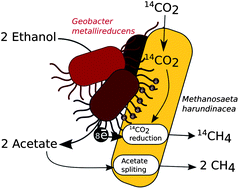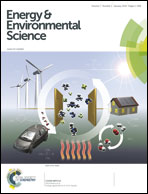A new model for electron flow during anaerobic digestion: direct interspecies electron transfer to Methanosaeta for the reduction of carbon dioxide to methane†
Abstract
Anaerobic conversion of organic wastes and biomass to methane is an important bioenergy strategy, which depends on poorly understood mechanisms of interspecies electron transfer to methanogenic microorganisms. Metatranscriptomic analysis of methanogenic aggregates from a brewery wastewater digester, coupled with fluorescence in situ hybridization with specific 16S rRNA probes, revealed that Methanosaeta species were the most abundant and metabolically active methanogens. Methanogens known to reduce carbon dioxide with H2 or formate as the electron donor were rare. Although Methanosaeta have previously been thought to be restricted to acetate as a substrate for methane production, Methanosaeta in the aggregates had a complete complement of genes for the enzymes necessary for the reduction of carbon to methane, and transcript abundance for these genes was high. Furthermore, Geobacter species, the most abundant bacteria in the aggregates, highly expressed genes for ethanol metabolism and for extracellular electron transfer via electrically conductive pili, suggesting that Geobacter and Methanosaeta species were exchanging electrons via direct interspecies electron transfer (DIET). This possibility was further investigated in defined co-cultures of Geobacter metallireducens and Methanosaeta harundinacea which stoichiometrically converted ethanol to methane. Transcriptomic, radiotracer, and genetic analysis demonstrated that M. harundinacea accepted electrons via DIET for the reduction of carbon dioxide to methane. The discovery that Methanosaeta species, which are abundant in a wide diversity of methanogenic environments, are capable of DIET has important implications not only for the functioning of anaerobic digesters, but also for global methane production.


 Please wait while we load your content...
Please wait while we load your content...